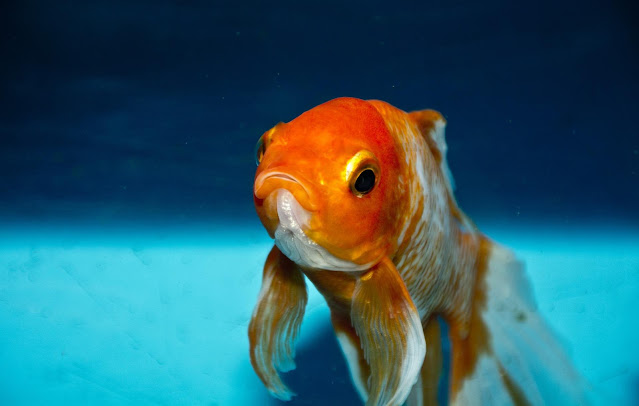Varieties of goldfish
Not all goldfish are red! And there are so many varieties that it's hard to know how many there are. They are the result of careful breeding and selection that began in China over 1,000 years ago. In the West, we didn't really know goldfish until the 17th century.
Selection is gradually developing, further increasing the number of varieties. This article gives you some pointers to help you find your place in the rich and diverse world of goldfish.
The elements that characterize goldfish
Of course, it is the anatomical features that distinguish goldfish species. It might be:
- Tail: single or double tail
- Scales: silver or not, beaded or not...
- Color: plain or speckled...
- head shape
- eye shape
- figure
- Presence of fins: caudal fin, dorsal fin, pectoral fin, pelvis.
There are 4 categories of traditional Chinese goldfish: "Ce", "Dragon Eye", "Wen", "Egg". But this classification is not taken up in the West.
So when you want to get a goldfish, you are spoiled. But there is an important criterion to know: the more the species deviates from the natural appearance of a goldfish, the more you have to be careful. It is necessary not to overestimate your ability to take care of your aquarium, on the one hand for the health of the fish and on the other hand to avoid disappointments and unnecessary expenses. They are beings themselves, with specific needs: taking care of them is an incremental learning process that deepens over time.
One more important point: whatever type of goldfish you choose, do not neglect the capacity of the aquarium. 50 liters is the minimum for one person. Pet store advisors are not experts: many beginners are wrongly advised to keep 20 litres.
Completeness is impossible and here we present to you 7 amazing varieties of goldfish.
The Oranda
Orandas are instantly recognizable by the protrusions placed on top of their heads, and their puffiness is reminiscent of raspberries. In older individuals, this swelling may appear in the eyes, blurring the vision of the fish. Unlike lion heads, Orandas have a dorsal fin.
Their length can reach 30 cm. They are also hardy fish and suitable for beginners.
The Lion Heads
The Lionhead Goldfish is one of the goldfish without a dorsal fin, such as the Lanchus, the Lionhead Goldfish, the Bubblefish... As a result, it swims rather slowly. Care must therefore be taken not to associate it with faster fish, particularly with regard to unequal access to food.
Its body is oval, and its name derives from the shape of its head, which is decorated with a projection at the level of the forehead and the operculum. Robust, with the possibility of starting the aquarium.
Telescopes
The main characteristic of telescopes is their spherical eyes, of variable shape: cones, circles... They are of little use to them because these fish have poor eyesight. Therefore, it is advisable to remove any unnecessary decoration in the aquarium, especially if it is pointed or sharp. But don't worry about their food: like all fish, they have a good sense of smell, which they use more to locate food.
Their bodies, like the eyes, are in all directions. Their colors are very diverse: red, orange, yellow, white, black (the most famous version is Black Moor), a combination of two or three colors. Their appearance can be matte, shiny or pearly. This breed dates back to the 16th century. Nevertheless, it is a fairly fragile fish for experienced aquarists.
The Ryukins
This breed is one of the oldest. It has a very nice fringed tail which makes it a popular ornamental fish. These fish are very robust and therefore both elegant and resistant: perfect for beginner aquarists.
The Shubunkins
These are fish made by Akiyama Jigoro by crossing a telescope fish with a common goldfish. They are similar in shape to common goldfish with an additional veiled tail. They have colored spots and sometimes metallic reflections. Their average length is 25 cm, and females are generally larger than males. There are 3 variations: London Shubunkins, Bristol Shubunkins and American Shubunkins. The latter are the most common in pet stores, which is good because they are easy to maintain and suitable for beginners.
The Pom Poms
In Pom Pom, the nostrils are well developed and form a clump of small balls at the front of the head. Evoking a bouquet of flowers, which the Japanese call Hanafusa, "bush of flowers", the name Pom Pom refers to the pompoms held up by American cheerleaders. Unlike the Japanese variant, the Chinese variant has no dorsal fin.
They belong to the large family of sail tails, that is, their tails are double, long and drooping, reminiscent of the shape of a sail. It is continuous, unlike fringe-tailed fish.
It is advisable to put the Pom Poms with very slow moving fish.
Comets
These fish are so called because they are the fastest goldfish.
Their speed is aided by a well-developed caudal fin, which can be as long as a fish's body. Therefore, the fish can reach a size of 40 cm. It can be yellow, orange, red or white, with the most popular version being a combination of red and white patterns.

